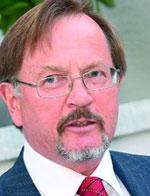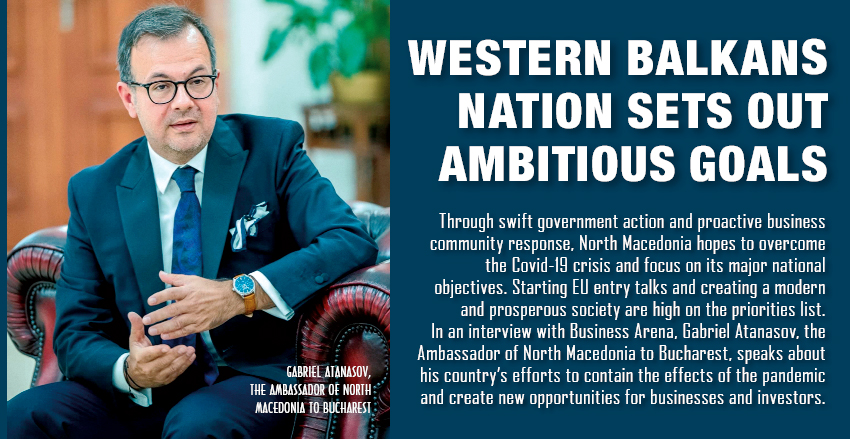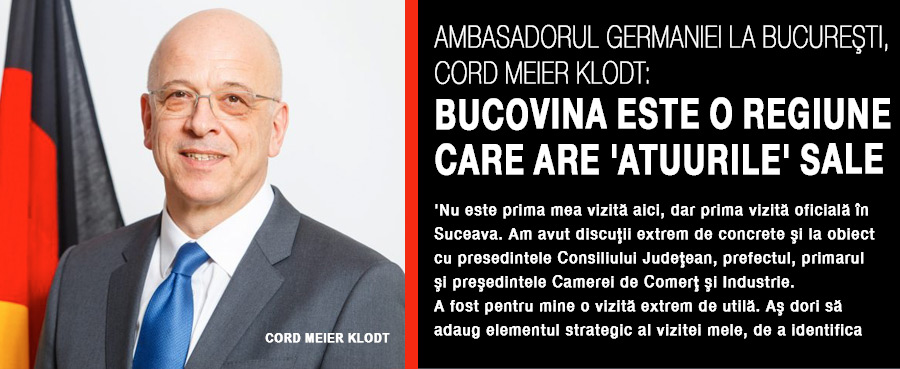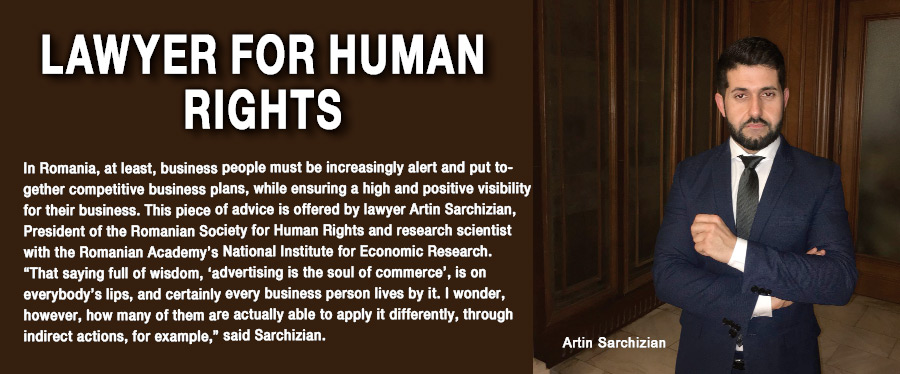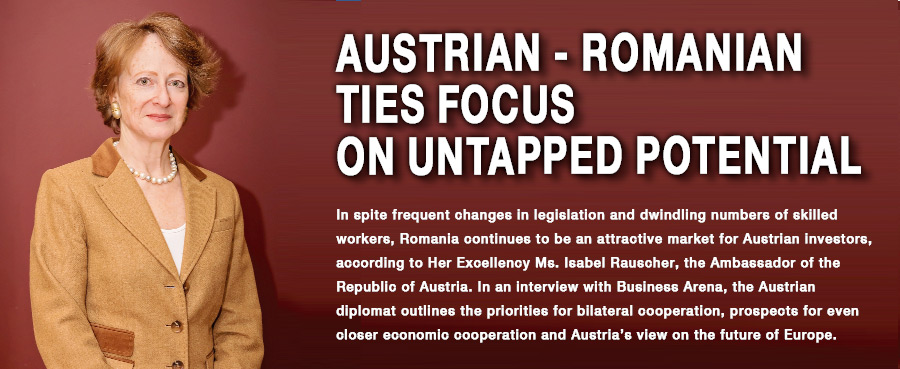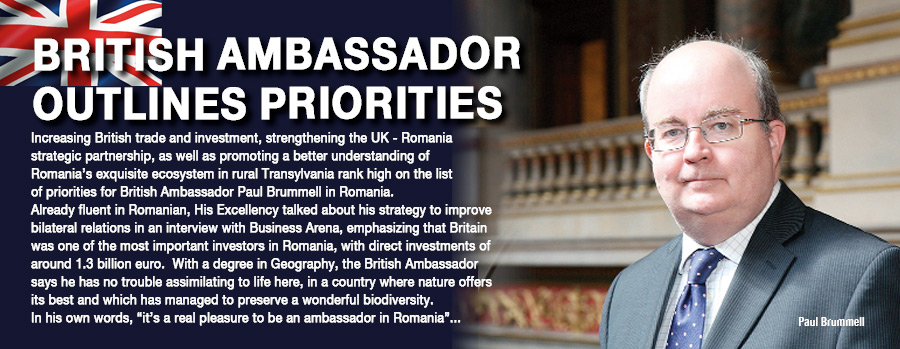Norway believes in Romania's development prospects
As Norwegian investments in Romania stand at around 300 million Euro and last year's bilateral trade amounted to 530 million Euro, the two countries have great potential for closer cooperation, according to Øystein Hovdkinn, the Norwegian Ambassador to Romania. "My embassy will do its utmost to support this potential being better exploited," he said, emphasizing that the maritime industry, an area of special expertise in Norway, has attracted a large part of the Norwegian investments in Romania.
Øystein Hovdkinn arrived in Bucharest in March 2008, prior to which he was Norway’s Consul General in Scotland. His responsibilities have increased since September 2008, when he also was accredited as the Norwegian Ambassador to the Republic of Moldova. “Norway has a development assistance program for Moldova amounting to around three million Euro per year. I try to go to Moldova on a regular basis, at least three or four times a year.”
Hovdkinn’s first contact with Romania occurred back in 2005, when he was the Deputy Secretary General of the European Free Trade Association (EFTA) in Brussels. “In November that year we organized in Bucharest a seminar on the European Economic Area (EEA), which integrates the three EFTA-countries Iceland, Liechtenstein and Norway in the EU internal market. At that stage it was clear to everybody that Romania was soon going to join the European Union and thereby would also automatically become a member of the EEA. I had the honor of opening that very successful seminar together with the then Romanian Chief negotiator with the EU, who later became the first Romanian EU-Commissioner, Leonard Orban.”
Referring to his main professional targets, Ambassador Hovdkinn says he is focused on promoting Norwegian interests in Romania. “There are many things to be done in this respect because historically speaking our two countries have not had close bilateral ties and relations. This is not surprising given our respective geographic locations in two opposite corners of Europe,” he said, adding that the Cold War and the Iron Curtain had added a political rift to the existing geographical distance between the two countries. “Nonetheless, Romania’s liberation in 1989 and its accession to NATO in 2004 and to the EU and the European Economic Area in 2007 have opened a wide door towards bilateral cooperation with Norway and other Western countries.” He noted that his main tasks involve offering assistance to Norwegian investors, encouraging closer bilateral political ties and organizing official visits.
The Ambassador also points out that Norway is amongst the largest donors to Romania: “Together with its EFTA-partners, Iceland and Liechtenstein, it will contribute 98.5 million Euro to the economic and social development of Romania between 2009–11, as part of the EEA Enlargement Agreement of July 2007.” Touching upon the details of the financial assistance arrangement, Hovdkinn said the funding was granted through two programmes, the EEA Financial Mechanism (EEA Grants) and The Norwegian Cooperation Programme for Romania (Norwegian Grants). “Of the total contribution, Norway allocates up to 98 per cent to supporting projects in the following focus areas: environment, energy efficiency, human resources, health and childcare, and cultural heritage. The continuation of the financial assistance for the period 2010–14 is another positive aspect in the relations between Romania and Norway, keeping in mind that the amount of funds made available for Romania will be tripled. This is a very fruitful platform for future development of partnerships between Romanian and Norwegian entities, whether private businesses, civil society or public bodies.”
Emphasizing Romania’s sizeable trade surplus with Norway, due mainly to Norway’s imports of ships built at Romanian shipyards, the Norwegian diplomat says that around 60 companies from his home country are operating in Romania. He indicated that the main sectors of interest for Norwegian investments in Romania included the maritime industry, shipbuilding, food industry, IT, engineering, energy and renewable energy, digital mapping and health technology. He mentions companies such as Orkla Foods, Blom Romania, Scandia Imagistica Cluj, STX RO Offshore, Barklav, and Ensyro.
Referring to bilateral trade last year, the Norwegian diplomat indicates that the imports from Romania represented around 0.67 per cent of Norway’s total imports, amounting to 393 million Euro. Specifically, Norway imported mainly ships (36 per cent of total imports), electrical machinery (14.4 per cent) and woven apparel (11.3 per cent) from Romania. “Since the ‘90s, the bilateral relations between our two countries have shown an impressive development. I am convinced that the economic exchanges between our two countries can only continue to grow in the coming years, considering that a large number of Norwegian companies have explored the opportunities to invest in Romania over the past two years.”
In spite of its current economic difficulties, Hovdkinn remains optimistic about Romania’s development prospects. “There is no doubt that Romania will continue developing after the crisis. At a recent Norwegian business forum, several companies expressed their intention to collaborate with the Embassy in order to launch investments in Romania,” he said, adding, “We must not be fooled by the rating agencies, because the data they offer is relative. In comparison to other countries, Romania has a safe political environment and it is part of the European internal market, as is Norway. There are difficulties everywhere, but Romania still has a favorable position, at least for the Norwegian companies.”
Although Norwegian investors generally find Romania a very attractive market, the Ambassador said there had been complaints about the business environment here, usually targeted at the slow and inefficient bureaucracy. “One such example is Statkraft, the largest hydro-power producing company in Norway. For a couple of years, the company has tried to establish partnerships with Romanian companies. I understand the process has not been easy due to problems related to bureaucracy and very difficult and cumbersome legislation. Therefore, at this point I am not sure what the final outcome might be. However, Statkraft has recently signed major contracts on hydro-power production with partners in Turkey and Albania. It is indeed surprising that a Norwegian company seems to find it easier to do business in Turkey and Albania than in the EU member state, Romania,” he said. “Some companies have also been confronted with corruption but most reports we receive claim that slow bureaucracy is a much bigger problem than corruption.”
Referring to the developments he has witnessed during his stay in Romania, he said that two years was a short time and no one could expect to see major changes. “I have, however, observed many minor changes. For example, I enjoy taking long walks in Bucharest, especially at weekends. It has been a pleasure for me to see the progress and improvements made in the Lipscani area, in the historic center of Bucharest. When I saw this district for the first time it reminded me of the old town of the Slovak capital, Bratislava, which I visited in 1994 and was then in a rather run-down state. When I visited it a few years later it had been transformed into one of the most beautiful old towns in Europe, attracting thousands of visitors from far and near. I think the Lipscani area has a similar potential of becoming a great tourist attraction,” he said. “Since I came to Bucharest in March 2008 I have also observed other things beginning to move in the right direction. For instance, a great infrastructure improvement was the building of the Baneasa tunnel. It is incredible what difference a short tunnel can make for the traffic. On my travels outside Bucharest I notice that the standards of hotels and tourist resorts such as those in Sinaia is steadily on the increase.” He added that tourism has great potential in Romania, but quality and the choice of hotels and restaurants should reach adequate levels if they are to attract more Western tourists. “In a longer term perspective, I also hope that modern highways will be built linking the main Romanian cities, which would encourage tourism and foreign investments. Improvements are under way but they seem to take more time than necessary.”
While his work takes up most of his time, Ambassador Øystein Hovdkinn likes to relax reading history books, listening to classical music, going to the Athenaeum and the Opera and walking. “My adult children live in Norway and Austria. My partner is a French diplomat who is also posted in Bucharest,” he said. He noted that in some ways Romania reminds him of Norway in his youth: “I grew up in the countryside and I was used to seeing horses and carts in the streets. Romania’s woodwork and handicraft tradition is also a quite similar to the Norwegian culture. I enjoy the mountains more than the coast, partly because I come from the Norwegian highlands myself and I prefer the beauty of the old towns and villages in Romania’s mountain areas.”
Hovdkinn’s first contact with Romania occurred back in 2005, when he was the Deputy Secretary General of the European Free Trade Association (EFTA) in Brussels. “In November that year we organized in Bucharest a seminar on the European Economic Area (EEA), which integrates the three EFTA-countries Iceland, Liechtenstein and Norway in the EU internal market. At that stage it was clear to everybody that Romania was soon going to join the European Union and thereby would also automatically become a member of the EEA. I had the honor of opening that very successful seminar together with the then Romanian Chief negotiator with the EU, who later became the first Romanian EU-Commissioner, Leonard Orban.”
Referring to his main professional targets, Ambassador Hovdkinn says he is focused on promoting Norwegian interests in Romania. “There are many things to be done in this respect because historically speaking our two countries have not had close bilateral ties and relations. This is not surprising given our respective geographic locations in two opposite corners of Europe,” he said, adding that the Cold War and the Iron Curtain had added a political rift to the existing geographical distance between the two countries. “Nonetheless, Romania’s liberation in 1989 and its accession to NATO in 2004 and to the EU and the European Economic Area in 2007 have opened a wide door towards bilateral cooperation with Norway and other Western countries.” He noted that his main tasks involve offering assistance to Norwegian investors, encouraging closer bilateral political ties and organizing official visits.
The Ambassador also points out that Norway is amongst the largest donors to Romania: “Together with its EFTA-partners, Iceland and Liechtenstein, it will contribute 98.5 million Euro to the economic and social development of Romania between 2009–11, as part of the EEA Enlargement Agreement of July 2007.” Touching upon the details of the financial assistance arrangement, Hovdkinn said the funding was granted through two programmes, the EEA Financial Mechanism (EEA Grants) and The Norwegian Cooperation Programme for Romania (Norwegian Grants). “Of the total contribution, Norway allocates up to 98 per cent to supporting projects in the following focus areas: environment, energy efficiency, human resources, health and childcare, and cultural heritage. The continuation of the financial assistance for the period 2010–14 is another positive aspect in the relations between Romania and Norway, keeping in mind that the amount of funds made available for Romania will be tripled. This is a very fruitful platform for future development of partnerships between Romanian and Norwegian entities, whether private businesses, civil society or public bodies.”
Emphasizing Romania’s sizeable trade surplus with Norway, due mainly to Norway’s imports of ships built at Romanian shipyards, the Norwegian diplomat says that around 60 companies from his home country are operating in Romania. He indicated that the main sectors of interest for Norwegian investments in Romania included the maritime industry, shipbuilding, food industry, IT, engineering, energy and renewable energy, digital mapping and health technology. He mentions companies such as Orkla Foods, Blom Romania, Scandia Imagistica Cluj, STX RO Offshore, Barklav, and Ensyro.
Referring to bilateral trade last year, the Norwegian diplomat indicates that the imports from Romania represented around 0.67 per cent of Norway’s total imports, amounting to 393 million Euro. Specifically, Norway imported mainly ships (36 per cent of total imports), electrical machinery (14.4 per cent) and woven apparel (11.3 per cent) from Romania. “Since the ‘90s, the bilateral relations between our two countries have shown an impressive development. I am convinced that the economic exchanges between our two countries can only continue to grow in the coming years, considering that a large number of Norwegian companies have explored the opportunities to invest in Romania over the past two years.”
In spite of its current economic difficulties, Hovdkinn remains optimistic about Romania’s development prospects. “There is no doubt that Romania will continue developing after the crisis. At a recent Norwegian business forum, several companies expressed their intention to collaborate with the Embassy in order to launch investments in Romania,” he said, adding, “We must not be fooled by the rating agencies, because the data they offer is relative. In comparison to other countries, Romania has a safe political environment and it is part of the European internal market, as is Norway. There are difficulties everywhere, but Romania still has a favorable position, at least for the Norwegian companies.”
Although Norwegian investors generally find Romania a very attractive market, the Ambassador said there had been complaints about the business environment here, usually targeted at the slow and inefficient bureaucracy. “One such example is Statkraft, the largest hydro-power producing company in Norway. For a couple of years, the company has tried to establish partnerships with Romanian companies. I understand the process has not been easy due to problems related to bureaucracy and very difficult and cumbersome legislation. Therefore, at this point I am not sure what the final outcome might be. However, Statkraft has recently signed major contracts on hydro-power production with partners in Turkey and Albania. It is indeed surprising that a Norwegian company seems to find it easier to do business in Turkey and Albania than in the EU member state, Romania,” he said. “Some companies have also been confronted with corruption but most reports we receive claim that slow bureaucracy is a much bigger problem than corruption.”
Referring to the developments he has witnessed during his stay in Romania, he said that two years was a short time and no one could expect to see major changes. “I have, however, observed many minor changes. For example, I enjoy taking long walks in Bucharest, especially at weekends. It has been a pleasure for me to see the progress and improvements made in the Lipscani area, in the historic center of Bucharest. When I saw this district for the first time it reminded me of the old town of the Slovak capital, Bratislava, which I visited in 1994 and was then in a rather run-down state. When I visited it a few years later it had been transformed into one of the most beautiful old towns in Europe, attracting thousands of visitors from far and near. I think the Lipscani area has a similar potential of becoming a great tourist attraction,” he said. “Since I came to Bucharest in March 2008 I have also observed other things beginning to move in the right direction. For instance, a great infrastructure improvement was the building of the Baneasa tunnel. It is incredible what difference a short tunnel can make for the traffic. On my travels outside Bucharest I notice that the standards of hotels and tourist resorts such as those in Sinaia is steadily on the increase.” He added that tourism has great potential in Romania, but quality and the choice of hotels and restaurants should reach adequate levels if they are to attract more Western tourists. “In a longer term perspective, I also hope that modern highways will be built linking the main Romanian cities, which would encourage tourism and foreign investments. Improvements are under way but they seem to take more time than necessary.”
While his work takes up most of his time, Ambassador Øystein Hovdkinn likes to relax reading history books, listening to classical music, going to the Athenaeum and the Opera and walking. “My adult children live in Norway and Austria. My partner is a French diplomat who is also posted in Bucharest,” he said. He noted that in some ways Romania reminds him of Norway in his youth: “I grew up in the countryside and I was used to seeing horses and carts in the streets. Romania’s woodwork and handicraft tradition is also a quite similar to the Norwegian culture. I enjoy the mountains more than the coast, partly because I come from the Norwegian highlands myself and I prefer the beauty of the old towns and villages in Romania’s mountain areas.”
S-ar putea să îți placă:
COMENTARII:
Fii tu primul care comenteaza

